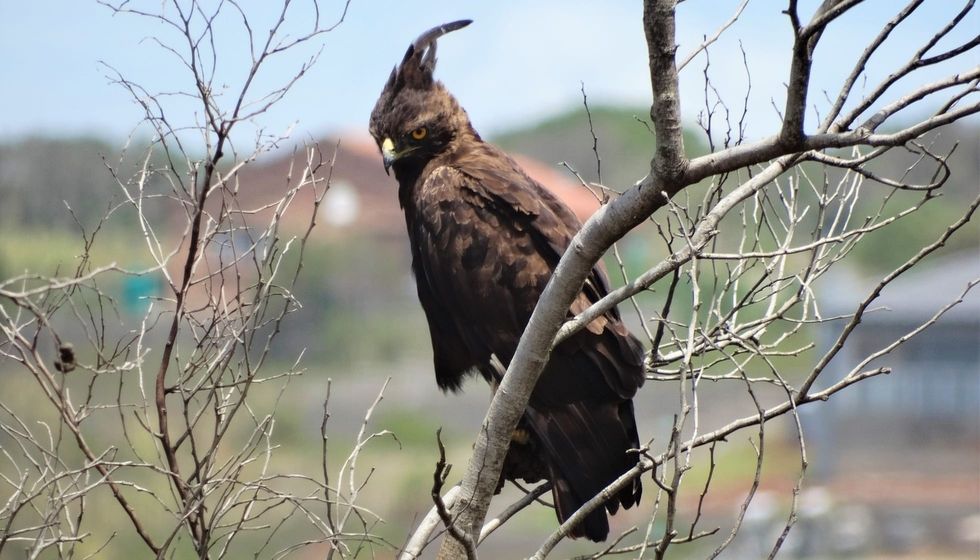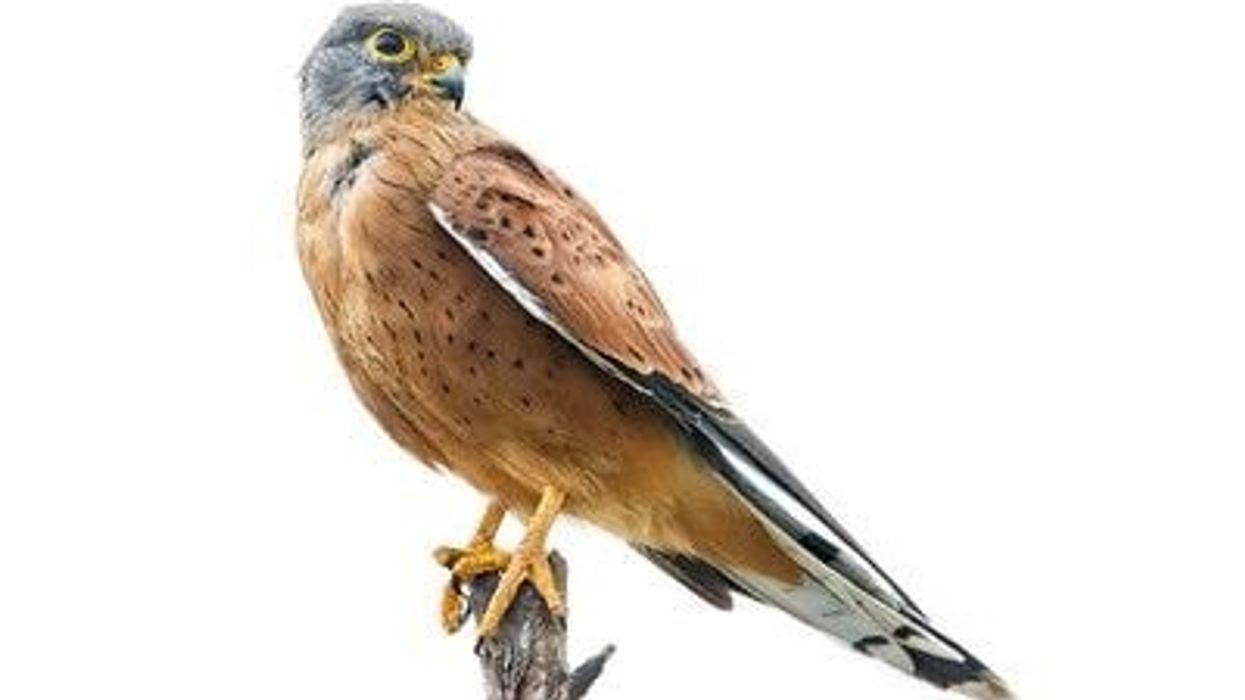The common and mostly heard name for many large birds of prey in the Accipitridae family is an eagle. The crested eagle (Morphnus guianensis) is a massive predatory eagle found in Central America.
Morphnus is the only genus in this eagle subspecies. Another well-known member of the same family is the long-crested eagle (Lophaetus occipitalis).
The breeding season for these birds falls between the dry season and the wet season in the tropical rainforests of Central America. Usually, their territory overlaps with the harpy eagle, but the crested eagle (Morphnus guianensis) tends to stay away from this larger eagle species.
Here are some interesting facts about the crested eagle. Afterward, check out some more fact files on interesting eagle species like the sea eagle and the steppe eagle.
Crested Eagle Interesting Facts
What type of animal is a crested eagle?
The crested eagle is the only type of eagle in the Morphnus genus of the family Accipitridae. This species is primarily found in the tropical rainforests of Central America, while the long-crested eagle (Lophaetus occipitalis) is found across Africa.
What class of animal does a crested eagle belong to?
Long-crested eagles belong to the aves class of animals. Long-crested eagles (Lophaetus occipitalis) belong to the family Accipitridae like all other eagles.
How many crested eagles are there in the world?
The long crested eagles total population is difficult to determine as their population is seen on a steady rise. As the conservation status for long-crested eagles (Lophaetus occipitalis) is that of Least Concern, their survival is presently not under any doubt.
Where does a crested eagle live?
Crested eagles can be found in tropical rainforests ranging from Central America to the central parts of South America. Crested eagles are seen in low densities throughout their vast range. On the other hand, the long-crested eagle (Lophaetus occipitalis) has its habitat spread across Africa.
What is a crested eagle's habitat?
The crested eagle habitat is humid lowland forests, the majority of which are tropical rainforests. They can withstand a lot of destruction in their habitat and are often found near secondary forests.
Who do crested eagles live with?
Long-crested eagles live alone for their whole life, except during the breeding season where these birds attract other sexes for mating. The habitat for Guiana crested eagle spans Guatemala, Costa Rica, Panama, Belize, Honduras, Nicaragua, Brazil, Paraguay, and Argentina.
How long does a crested eagle live?
Crested eagles may live up to five to seven years depending on the type of environment they live in.
How do they reproduce?
Crested eagles mate in monogamous pairs and stay together all year, once the pair has been formed. Pairs soaring and calling together makeup courtship displays.
The nest is in the shape of a cup and is placed at the fork of a large tree, usually concealed near the canopy.
After the mating process is over, the female long-crested eagle will lay only two eggs in the nest which she will hatch all by herself while the male takes care of the food. Males tend to stay near the same tree where the eggs are laid.
What is their conservation status?
The crested eagle is listed as a species of Least Concern in terms of the conservation efforts required. They are a familiar sight in some parts of Central America. The study of isolated island populations, on the other hand, may yield specific subspecies.
Crested Eagle Fun Facts
What do crested eagles look like?
Thanks to its long, shaggy crown and dark plumage, the long-crested eagle is easily identified. Adults are blackish-brown in color with long, thin feathers rising from the back of the crown and holding upright to form a crest.
Primary feathers are black with light gray bars and broad black tips. Adults' eyes are light gold, but females' eyes can be darker, and their cere and feet are black.

*Please note that this image is of a long crested eagle, not a crested eagle. If you have an image of a crested eagle, please let us know at hello@kidadl.com
How cute are they?
The crested serpent eagle looks fabulous when this bird is seen flying high above in the sky looking for prey. These birds look adorable to some who have experience keeping such eagles as pets.
How do they communicate?
Crested serpent eagles use auditory signals and aerial displays to communicate with one another. Their courtship routine is fairly complicated, requiring several diving runs and reciprocal soaring. This bird species can often be seen flying over a tree, producing a distinct call.
How big is a crested eagle?
The long-crested eagle is three times bigger than the South Nicobar serpent eagle. The crested eagle is 28–35 in (71.1-88.9 cm) size with a wingspan of around 55-70 in (139.7-177.8 cm).
How fast can a crested eagle fly?
A crested eagle will dive down on prey at speeds of up to 100 mph (160 kph) and come to a stop in less than 20 ft (6 m).
How much does a crested eagle weigh?
A crested eagle bird weighs anywhere from 2.9-6.6 lb (1.31-2.99 kg).
What are the male and female names of the species?
There is no specific name for a male and female crested eagle. They are known as male crested eagles and female crested eagles respectively.
What would you call a baby crested eagle?
A baby crested eagle is called an eaglet. They have a white head and chest along with gray wings. In the second year, their feathers and body turn sandy gray. The dark morph juveniles are usually dark brown to gray in color.
The distinctive juvenile crested eagle is white on the head and chest, with a marbled-gray coloration on the back and wings. They turn to a sandy-gray color in the second year of life. Dark morph juveniles are similar but are dark brownish-gray from an early age.
What do they eat?
Crested eagles are hardy carnivores. They feed mainly on snakes, although they are not limited to non-venomous animals. Eagles also consume a wide range of small rodents, primates, and birds.
Are they dangerous?
Yes, crested eagles are the most powerful predators. Crested eagles have been known to attack humans, but the injuries they cause are not fatal. Crested eagles become even more territorial during mating season. It is safest to maintain a reasonable distance from a long-crested eagle.
Would they make a good pet?
No, crested eagles cannot be kept as pets, since these bird species are extremely aggressive. Only an experienced handler can keep them as pets.
Did you know...
Crested serpent eagles are a kind of eagle with a grip that is up to 10 times stronger than that of humans.
An eagle's vision is up to eight times sharper than that of a human.
Some other interesting eagles include the mountain hawk-eagle, the Javan hawk-eagle, and the booted eagle.
Crested eagles around the world
Long-crested eagles can be found from Senegambia to Ethiopia, as well as in northern Namibia, Botswana, and South Africa, spanning a latitude range of 17°S to 34°S. Adults are sedentary, although they may travel to areas with more fruit, and they are semi-nomadic in regions with distinct wet and dry seasons.
Comparisons with other eagles
The harpy eagle is the world's largest extant eagle, with talons as thick as a grizzly bear's paw. The crested eagle is similar to the harpy eagle in size.
Here at Kidadl, we have carefully created lots of interesting family-friendly animal facts for everyone to discover! Learn more about some other arthropods from our stork facts and great white pelican facts pages.
You can even occupy yourself at home by coloring in one of our eagle mask coloring pages.










